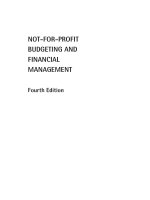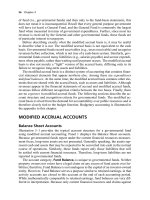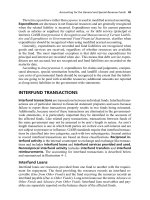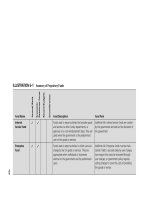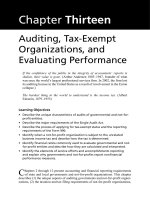Not for profit accouting
Bạn đang xem bản rút gọn của tài liệu. Xem và tải ngay bản đầy đủ của tài liệu tại đây (1.13 MB, 256 trang )
Not-for-Profit
Accounting
Made Easy
Second
Edition
Warren Ruppel
John Wiley & Sons, Inc.
Not-for-Profit
Accounting
Made Easy
Second
Edition
Not-for-Profit
Accounting
Made Easy
Second
Edition
Warren Ruppel
John Wiley & Sons, Inc.
This book is printed on acid-free paper.
Copyright © 2007 by John Wiley & Sons, Inc. All rights reserved.
Wiley Bicentennial Logo: Richard J. Pacifico
Published by John Wiley & Sons, Inc., Hoboken, New Jersey
Published simultaneously in Canada
No part of this publication may be reproduced, stored in a retrieval system, or
transmitted in any form or by any means, electronic, mechanical,
photocopying, recording, scanning, or otherwise, except as permitted under
Section 107 or 108 of the 1976 United States Copyright Act, without either the
prior written permission of the Publisher, or authorization through payment of
the appropriate per-copy fee to the Copyright Clearance Center, Inc., 222
Rosewood Drive, Danvers, MA 01923, 978-750-8400, fax 978-750-4470, or
on the Web at www.copyright.com. Requests to the Publisher for permission
should be addressed to the Permissions Department, John Wiley & Sons, Inc.,
111 River Street, Hoboken, NJ 07030, 201-748-6011, fax 201-748-6008, or
online at />Limit of Liability/Disclaimer of Warranty: While the publisher and author
have used their best efforts in preparing this book, they make no
representations or warranties with respect to the accuracy or completeness of
the contents of this book and specifically disclaim any implied warranties of
merchantability or fitness for a particular purpose. No warranty may be
created or extended by sales representatives or written sales materials. The
advice and strategies contained herein may not be suitable for your situation.
You should consult with a professional where appropriate. Neither the
publisher nor author shall be liable for any loss of profit or any other
commercial damages, including but not limited to special, incidental,
consequential, or other damages.
For general information on our other products and services, please contact our
Customer Care Department within the United States at 800-762-2974, outside
the United States at 317-572-3993 or fax 317-572-4002.
Wiley also publishes its books in a variety of electronic formats. Some content
that appears in print may not be available in electronic books. For more
information about Wiley products, visit our Web site at www.wiley.com
ISBN: 978-0-471-78979-6
Printed in the United States of America
10 9 8 7 6 5 4 3 2 1
Contents
Chapter 1
Chapter 2
Chapter 3
Preface
ix
Understanding the Basics of Not-for-Profit Accounting
What Are Generally Accepted Accounting Principles?
Why Is Preparing GAAP Financial Statements Important?
Definitions and Examples of Assets, Liabilities, Revenues, and Expenses Usually Found in Not-for-Profit
Organizations’ Financial Statements
What Is Meant by the Accrual Basis of Accounting?
How Does This Differ from the Cash Basis of Accounting, and Which Is Better?
What Happened to Fund Accounting?
Summary
1
Basic Financial Statements of a Not-for-profit Organization
Statement of Financial Position
Statement of Activities
Statement of Cash Flows
Summary
Accounting for Contributions
When Should Contributions Be Recorded?
Understanding the Impact of Donor Restrictions on the
Reporting of Contributions
Accounting for Contributed Services
Accounting for Other Noncash Contributions
Pass-Through Contributions
Summary
v
1
2
6
36
40
42
43
44
46
56
63
65
66
72
74
75
76
82
Chapter 4
Chapter 5
Accounting for Investments and Financial Instruments
Accounting for Investments
Accounting and Financial Reporting for Financial Instruments
Summary
Accounting for Activities with Joint Costs and Indirect Cost Allocation
Accounting for the Costs of Activities that Include
Fund-Raising
Allocation Methods
Indirect Cost Allocation Plans
Summary
83
84
98
107
109
110
117
119
124
Chapter 6
Affiliated Organizations
Affiliated Organizations
For-Profit Subsidiaries
Related-Party Disclosures
Summary
125
126
135
137
140
Chapter 7
Collections
What Is a Collection?
Accounting for Collections
Summary
141
142
143
146
Chapter 8
Split-Interest Agreements
Accounting Fundamentals
Revocable Split-Interest Agreements
Irrevocable Split-Interest Agreements
Examples of Split-Interest Agreements
Summary
147
148
149
150
153
158
Chapter 9
Accounting for Pension and Other Postretirement
Employee Benefit Plans
Accounting for Pension Plans
Determining Pension Expense
Determining Pension Liability
Actuarial Assumptions and Calculations
Required Disclosures
Deferred Compensation Plans
Other Postretirement Benefits
Disclosures
Summary
159
vi
160
164
165
168
171
172
173
176
177
Chapter 10
Lease Accounting Fundamentals
Lease Accounting
Operating versus Capital Leases
Operating Leases
Operating Leases with Scheduled Rent Increases
Free Rent Periods
Capital Leases
Summary
179
180
180
185
187
188
189
193
Chapter 11
Analyzing the Financial Health of Not-for-Profit
Organizations
Financial Statement Analysis
Independent Auditor’s Report
Comparative Financial Statements
Functional Expense Ratios and Other Analyses
Budget Considerations in Financial Analysis
Relation of the Budget to the Financial Statements
Methods of Budgetary Control
Summary
195
197
197
201
203
213
214
216
218
Current Developments in Not-for-Profit GAAP
Recent FASB Statements
Summary
221
222
228
Index
229
Chapter 12
vii
Preface
Not-for-Profit Accounting Made Easy is a plain-language, easy to
understand explanation of the various accounting and financial reporting
practices of not-for-profit organizations. It is designed for all those individuals
who have contact with these organizations—management and staff, board
members (particularly audit committee members), consultants, donors,
creditors—who should understand not-for-profit accounting but often do not.
It is written for the nonaccountant, but those accountants who are unfamiliar
with the nuances of not-for-profit accounting (or those who have grown a little
rusty in the latest accounting pronouncements) and do not need an in-depth
technical volume will also find it useful.
There are over one million not-for-profit organizations in the United
States. They exist in all sizes and for many purposes. They range from
homeless shelters to country clubs, from child day care centers to colleges and
universities, from local to international. One thing these organizations all have
in common is that their finances are subject to a great deal of scrutiny.
Since the publication of the first edition of this book, the accounting
“industry” has undergone dramatic changes. Well-publicized accounting
failures and frauds in large public companies led to the passage of the
Sarbanes-Oxley Act of 2002. Although not applicable directly to not-forprofit organizations (except for some specific provisions that apply to all
organizations with respect to protecting the rights of “whistle-blowers”), it is
the trickle-down effect of these changes that have indirectly affected not-forprofit organizations. These changes will be discussed where applicable in this
newly revised edition of this book, but there is no doubt that overall, not-forprofit organizations face increased scrutiny of their accounting and financial
practices.
Effective accounting and financial reporting is a key ingredient in
withstanding this increased scrutiny and ensuring accountability. Having a
basic understanding of not-for-profit accounting and financial reporting can be
a real asset for the many people who have contact with not-for-profit
organizations in many different ways. This book is particularly important for
a not-for-profit organization’s management and governing board who need a
basic level of understanding of accounting and financial reporting to fulfill
their fiduciary responsibilities. This book may not make you love not-forprofit accounting, but it will teach you the basics and help you read and
understand a set of not-for-profit financial statements.
ix
My thanks to all those at John Wiley & Sons, Inc., who helped make this
book a reality, particularly John DeRemigis who supported and nurtured the
concept and Judy Howarth and Pam Reh for making sure that the book is a
quality product. Thanks also to my family, my wife Marie and sons
Christopher and Gregory, for their continued support.
Warren Ruppel
Woodcliff Lake, New Jersey
January 2007
x
About the Author
Warren Ruppel, CPA, has over 25 years of expertise in not-for-profit
and governmental accounting. He is currently the Director of Government
Services at Marks Paneth & Shron LLP where he is also a key member of the
firm’s quality assurance team. He previously was the assistant comptroller for
accounting of the City of New York, where he was responsible for all aspects
of the City’s accounting and financial reporting. He began his career at
KPMG after graduating from St. John’s University, New York. He later
joined Deloitte & Touche to specialize in audits of not-for-profit organizations
and governments. Mr. Ruppel has also served as the chief financial officer of
an international not-for-profit organization and as a partner in a small CPA
practice.
Mr. Ruppel has served as instructor for many training courses, including
specialized governmental and not-for-profit programs and seminars. He has
also been an adjunct lecturer of accounting at the Bernard M. Baruch College
of the City University of New York. He is the author of five other books,
OMB Circular A-133 Audits, Not-for-Profit Organization Audits, and Wiley’s
Not-for-Profit Audit Committee Best Practices, GAAP for Governments, and
Governmental Accounting Made Easy.
Mr. Ruppel is a member of the American Institute of Certified Public
Accountants as well as the New York State Society of Certified Public Accountants, where he serves on the Governmental Accounting and Auditing
Committee and as a member of the Not-for-Profit Organizations Committee.
He has also served as chair of the Society’s Audit Committee. He is also a
past president of the New York Chapter of the Institute of Management Accountants. Mr. Ruppel is a member of the Government Finance Officers Association and serves on its Special Review Committee.
xi
Not-for-Profit
Accounting
Made Easy
Second
Edition
CHAPTER 1
Understanding the Basics of
Not-for-Profit Accounting
This chapter provides some very basic information about not-forprofit accounting to provide a basis for understanding the principles and standards that are discussed in greater detail throughout
the remainder of this book. A lack of understanding or misunderstanding of these fundamentals will cause the reader to be lost
when trying to understand more complex principles. Specifically, this chapter will
• Identify generally accepted accounting principles.
• Define and give examples of assets, liabilities, net assets,
revenues, and expenses usually found in not-for-profit organizations’ financial statements.
• Explain what is meant by the accrual basis of accounting.
How does this differ from the cash basis of accounting, and
which is better?
• Describe what happened to fund accounting.
WHAT ARE GENERALLY ACCEPTED ACCOUNTING
PRINCIPLES?
Nonaccountants sometimes ask the question, “Well, if these accounting principles are only generally accepted, that must mean
that there are other perfectly good accounting principles that have
1
2
Understanding the Basics of Not-for-Profit Accounting
less than general acceptance that are fine to use.” Unfortunately
for those desiring creativity and uniqueness in their accounting
principles, this is not the case. Generally accepted accounting
principles (GAAP) are the rules of road that need to be followed
by not-for-profit organizations if they want to proclaim that their
financial statements are prepared in accordance with GAAP.
WHY IS PREPARING GAAP FINANCIAL STATEMENTS
IMPORTANT?
Sometimes not-for-profit organizations are required by law or
regulation to prepare financial statements in accordance with
GAAP. Most states require that not-for-profit organizations that
are organized within a state (or raise funds within that state) file
an annual report with the state charities bureau (or its equivalent)
and, for all but the smallest not-for-profit organizations, the annual reports usually require that financial statements prepared in
accordance with GAAP be included with the annual report.
Several other groups are also important users of financial
statements prepared in accordance with GAAP. Large, sophisticated donors often request copies of an organization’s financial
statements, and having these financial statements prepared in accordance with GAAP lends a high degree of credibility to the financial statements. Creditors that loan money or provide credit
lines to not-for-profit organizations also like to see GAAP financial statements. Sometimes a significant vendor or contractor
will also request financial statements of the organization, particularly when a long-term lease or equipment-financing contract
is being executed. Having financial statements prepared in accordance with GAAP makes them more understandable, comparable with other not-for-profit organizations, and provides a better representation of the financial affairs of the not-for-profit organization. Additionally, if the not-for-profit organization provides services to a governmental organization (federal, state, city,
school district, county, etc.), the contract with the governmental
entity often requires that financial statements prepared in accordance with GAAP be submitted to the government every year.
Why Is Preparing GAAP Financial Statements Important?
3
Who Sets the Laws of GAAP?
Generally accepted accounting principles for not-for-profit organizations are basically set by the Financial Accounting Standards Board (FASB). The FASB is a private organization that is
overseen by the Financial Accounting Foundation (FAF), itself a
not-for-profit organization. The FASB issues GAAP accounting
pronouncements that relate to commercial entities (both public
and private) as well as not-for-profit organizations. The FAF
also oversees the Governmental Accounting Standards Board
(GASB), which sets GAAP for governmental entities. The
American Institute of Certified Public Accountants (AICPA) has
also issued accounting guidance in the past that is part of the accounting principles that comprise GAAP for not-for-profit organizations.
Who Makes Sure the Not-For-Profit Organization’s Financial
Statements Conform with GAAP?
The answer may surprise the nonaccountant, but the fair presentation of a not-for-profit organization’s financial position and
activities in its financial statements prepared in accordance with
GAAP is the responsibility of the not-for-profit organization’s
management. For those who would have guessed this responsibility was that of the not-for-profit organization’s independent
auditor, a serious change in paradigm needs to be made. Independent auditors are hired to perform an audit and issue an opinion as to whether the financial statements prepared by management are presented in accordance with GAAP. Not-for-profit organizations often rely on the independent auditors to help them
meet their responsibility for preparing financial statements. The
common reason for doing this, particularly in smaller organizations, is that the not-for-profit organization may not have individuals with the technical expertise on staff to take full responsibility for preparing the financial statements. While it is understandable how this happens, the management of the organization
is, in fact, responsible for the financial statements. If assistance
is needed of the independent auditor, management should at least
understand how the financial statements are ultimately prepared
4
Understanding the Basics of Not-for-Profit Accounting
and what types of adjustments to the organization’s books and
records are being made by the independent auditor to result in
GAAP financial statements. In fact, for an auditor to maintain
independence, under AICPA standards, management is required
to designate an individual with suitable knowledge and experience to oversee these types of “nonattest” (i.e. nonaudit) services
performed by the independent auditor.
It is worth noting, however, that independent auditors take the
fact that the financial statements are management’s responsibility
very seriously. The second sentence of a standard auditor’s
opinion letter states: “These financial statements are the responsibility of XYZ’s management.” While this is most assuredly an
attempt by independent auditors to limit their legal exposure in
case the financial statements actually are not prepared in accordance with GAAP, it does highlight the fact that the financial
statements are management’s responsibility.
What Happens if the Financial Statements Are Not in
Accordance with GAAP?
It depends. If a not-for-profit organization prepares financial
statements that its management believes are in accordance with
GAAP while its independent auditor does not believe they are in
accordance with GAAP, one of two things can happen:
• The not-for-profit organization accepts changes to the
statements prepared by the auditor and corrects the financial statements. In this case, both management and the independent auditor now believe the financial statements are
prepared in accordance with GAAP. The problem is resolved and the independent auditor issues an unqualified
opinion on the financial statements.
• The not-for-profit organization may disagree with the
changes proposed by the auditor. On the other hand, the
independent auditor may propose that an adjustment be
made to the financial statements or that additional disclosures be included, but the management of the not-for-profit
organization does not believe that it is appropriate or necessary to adjust the financial statements. In this case, the
Why Is Preparing GAAP Financial Statements Important?
5
auditor will issue a qualified opinion on the financial statements because of the departure from GAAP. This means
that, in the opinion of the auditor, the financial statements
are prepared in accordance with GAAP, with the exception
of the problem item. In some rare cases, if the problem is
so serious that it is pervasive and affects the financial
statements as a whole, the auditor may issue an adverse
opinion on the financial statements. This means that the financial statements in their entirety are not prepared in accordance with GAAP.
The acceptance of financial statements that are not in accordance with GAAP will vary among the different users of those
financial statements. A state charities office may accept financial
statements that are qualified for a GAAP exception, but may not
accept statements with an adverse opinion. A bank or other
creditor may find that any departure from GAAP in a not-forprofit organization’s financial statements is a negative factor in
determining whether credit should be granted to the not-for-profit
organization.
Tip A not-for-profit organization may deliberately choose not to
use GAAP for its financial statements, but rather an “other comprehensive basis of accounting” (OCBOA), such as the cash
basis, for the statements. More on this topic will be provided
later in this chapter.
The bottom line of this discussion is that GAAP is widely recognized as providing the best information about a not-for-profit organization’s financial position and activities. For all but the
smallest not-for-profit organizations (which may not even issue
financial statements), it is likely that the benefits of having financial statements prepared in accordance with GAAP will outweigh
the costs.
Red Flag Not-for-profit organizations often prepare annual financial statements on a GAAP basis, while providing their board
6
Understanding the Basics of Not-for-Profit Accounting
of directors or executive management with financial information
on a quarterly basis, particularly including budget-to-actual comparisons. The total of all four quarters of these quarterly financial
information reports often does not equal amounts reported in financial statements prepared in accordance with GAAP, because
there are frequently adjustments made to conform to GAAP that
are only made when the annual financial statements are prepared.
Common examples include depreciation expense, bad debt expense, and inventories (each of which will be discussed later in
greater detail), which are only recorded annually and not reflected in quarterly financial information.
DEFINITIONS AND EXAMPLES OF ASSETS, LIABILITIES,
REVENUES, AND EXPENSES USUALLY FOUND IN NOTFOR-PROFIT ORGANIZATIONS’ FINANCIAL STATEMENTS
In order to understand the basic financial statements of a not-forprofit organization and how various transactions are accounted
for under GAAP, the reader needs to understand the various asset, liability, revenue, and expense accounts typically found in the
financial statements of not-for-profit organizations. Some accounts are easier to describe (for example, cash) than others (for
example, deferred charges). Even with the easier accounts, there
are often underlying rules that need to be understood to really
comprehend the financial statement item being reported. Using
the example of cash, the financial statement reader might be interested in knowing the distinctions between unrestricted cash
and restricted cash and how each is reported. The financial
statement reader might also be interested in knowing what cash
equivalents are, which are sometimes included in the financial
statement line item “Cash and cash equivalents.” The point is
that there are any number of nuances and requirements that have
developed that determine how items are reported. The following
pages describe some of the more common items encountered in
not-for-profit financial accounting. (Again, note that this discussion provides only basic rules. Financial statement preparers
need to refer to the comprehensive rules found in other sources,
such as Wiley’s Not-for-Profit GAAP, which is written for those
Not-for-Profit Accounting Definitions and Examples
7
requiring a more in-depth understanding of the GAAP requirements.)
Assets
Let us start by looking at the GAAP definition of an asset. FASB
Concepts Statement No. 6, “Elements of Financial Statements”
(FASBCS 6), defines assets in the following way: “Assets are
probable future economic benefits obtained or controlled by a
particular entity as a result of past transactions or events.” And
all this time you thought that assets were things you owned! The
fact is, the FASB definition is meant to provide a broader context
to assets, rather than a narrower definition that only implies ownership. For example, if a not-for-profit organization prepays its
liability insurance premium for the following year, it really does
not “own” anything as a result of that prepayment. However, the
prepayment will provide a future economic benefit to the not-forprofit organization, which will be insured during the following
year without having to pay an insurance premium in that year.
Thinking of assets as including things that the organization owns
as well as future economic benefits that it is entitled to will help
the reader understand what types of items are considered assets.
Note also that assets are measured in financial statements as
of a point in time, that is, as of the date of the statement of financial position, which is sometimes referred to as the balance sheet.
For example, if the not-for-profit organization’s fiscal year-end is
June 30, its statement of financial position will report its assets as
of that date. Assets are also presented in the statement of financial position in their order of liquidity, which means the assets
that can be converted the most readily into cash are reported first.
More information on this concept will be presented in Chapter 2.
Some of the types of assets often found on a not-for-profit organization’s statement of financial position are
•
•
•
•
•
Cash
Cash equivalents
Investments
Contributions (sometimes called pledges) receivable
Accounts receivables
8
Understanding the Basics of Not-for-Profit Accounting
•
•
•
•
Other receivables
Inventories
Property, plant, and equipment
Prepaid expenses
Cash
Cash is a fairly obvious asset. It represents the balances in the
not-for-profit organization’s bank accounts. The presentation of
cash represents the book balances of the bank accounts, not the
amounts reported on the bank statements. The book balances are
similar to what individuals keep as balances in their own checkbooks, that is, checks that have been written and deducted from
the balance but that have not yet cleared the bank. Similarly, deposits that have been received but have not yet cleared the bank
are also included in the balance.
The cash amount reported on the statement of financial position should include
• All demand bank accounts that the not-for-profit organization has, including those for general disbursements, payroll
accounts, separate accounts for wire transfers, and so
forth. (One cash balance is reported on the financial statements representing the aggregation of all of these accounts).
• All petty cash accounts that are maintained by the not-forprofit organization.
Cash that is reported on the statement of financial position
should not include
• Cash that is restricted by some legally enforceable instrument. Generally, this would include cash maintained in
debt service reserve accounts required to be maintained by
the related debt instruments. Restricted cash is shown as a
separate line item in the statement of financial position to
make it clear to the reader that is not available to pay the
not-for-profit organization’s current bills.
• Cash that is received and held as a security deposit that
will be returned to the provider at the end of some agree-




